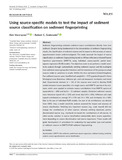JavaScript is disabled for your browser. Some features of this site may not work without it.
| dc.contributor.author | Vercruysse, Kim | |
| dc.contributor.author | Grabowski, Robert | |
| dc.date.accessioned | 2019-08-29T14:11:07Z | |
| dc.date.available | 2019-08-29T14:11:07Z | |
| dc.date.issued | 2018-08-31 | |
| dc.identifier.citation | Vercruysse K, Grabowski RC. Using source-specific models to test the impact of sediment source classification on sediment fingerprinting. Hydrological Processes, Volume 32, Issue 22, October 2018 pp. 3402-3415 | en_UK |
| dc.identifier.issn | 0885-6087 | |
| dc.identifier.uri | https://doi.org/10.1002/hyp.13269| | |
| dc.identifier.uri | http://dspace.lib.cranfield.ac.uk/handle/1826/14482 | |
| dc.description.abstract | Sediment fingerprinting estimates sediment source contributions directly from river sediment. Despite being fundamental to the interpretation of sediment fingerprinting results, the classification of sediment sources and its impact on the accuracy of source apportionment remain underinvestigated. This study assessed the impact of source classification on sediment fingerprinting based on diffuse reflectance infrared Fourier transform spectrometry (DRIFTS), using individual, source‐specific partial least‐squares regression (PLSR) models. The objectives were to (a) perform a model sensitivity analysis through systematically omitting sediment sources and (b) investigate how sediment source‐group discrimination and the importance of the groups as actual sources relate to variations in results. Within the Aire catchment (United Kingdom), five sediment sources were classified and sampled (n = 117): grassland topsoil in three lithological areas (limestone, millstone grit, and coal measures); riverbanks; and street dust. Experimental mixtures (n = 54) of the sources were used to develop PLSR models between known quantities of a single source and DRIFTS spectra of the mixtures, which were applied to estimate source contributions from DRIFTS spectra of suspended (n = 200) and bed (n = 5) sediment samples. Dominant sediment sources were limestone topsoil (45 ± 12%) and street dust (43 ± 10%). Millstone and coals topsoil contributed on average 19 ± 13% and 14 ± 10%, and riverbanks 16 ± 18%. Due to the use of individual PLSR models, the sum of all contributions can deviate from 100%; thus, a model sensitivity analysis assessed the impact and accuracy of source classification. Omitting less important sources (e.g., coals topsoil) did not change the contributions of other sources, whereas omitting important, poorly‐discriminated sources (e.g., riverbank) increased the contributions of all sources. In other words, variation in source classification substantially alters source apportionment depending on source discrimination and source importance. These results will guide development of procedures for evaluating the appropriate type and number of sediment sources in DRIFTS‐PLSR sediment fingerprinting. | en_UK |
| dc.language.iso | en | en_UK |
| dc.publisher | Wiley | en_UK |
| dc.rights | Attribution 4.0 International | * |
| dc.rights.uri | http://creativecommons.org/licenses/by/4.0/ | * |
| dc.subject | Sediment tracing | en_UK |
| dc.subject | source identification | en_UK |
| dc.subject | DRIFTS | en_UK |
| dc.subject | sensitivity analysis | en_UK |
| dc.subject | discrimination | en_UK |
| dc.subject | partial least squares regression | en_UK |
| dc.subject | fine sediment | en_UK |
| dc.subject | source apportionment | en_UK |
| dc.title | Using source-specific models to test the impact of sediment source classification on sediment fingerprinting | en_UK |
| dc.type | Article | en_UK |
Files in this item
The following license files are associated with this item:
This item appears in the following Collection(s)
-
Staff publications (SWEE) [2825]

